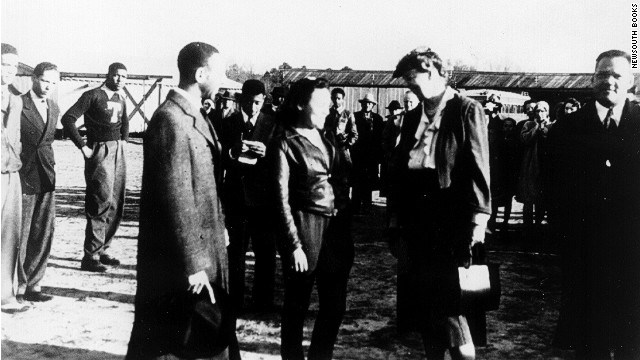
One person to follow in Bessie Coleman’s footsteps was Willa Brown (1906—1992). A high-school teacher by age 21, she started flight lessons at Aeronautical University in Chicago in 1934. Over the next few years, Willa Brown became a certified master mechanic, earned an MBA from Northwestern University, and became the first African American woman to receive a private pilot’s lesson in the United States. She and her husband Cornelius Coffey opened the Coffey School of Aeronautics near Chicago. The Coffey school trained pilots for the Civilian Pilot Training Program (CPTP) and sent students on to the Army Air Force program at Tuskegee as both cadets and pilot instructors. As director of the Coffey School, Willa Brown was responsible for training over 200 future Tuskegee Airmen and was an advocate for inclusion of African American pilots in the CPTP and the armed forces. Another female pilot was even more closely connected with Tuskegee. Mildred Hemmons Carter (1921—2011) earned her BA in business from Tuskegee when she was only 19. Being at Tuskegee gave her the opportunity to learn to fly from head flight instructor Chief Anderson. Mildred Hemmons graduated with the first class of Civilian Pilot Training Program and went on to earn her private pilot’s license in 1941. She also met her husband, Herbert Carter, during this time. As cadets, they were unable to date. Instead, they would make plans to meet in the air with Mildred flying a Piper Cub and Herbert flying whatever plane was scheduled for a maintenance flight check. They would meet at a designated time over Lake Martin. Mildred and Herbert married in 1942 after his graduation and appointment as a lieutenant. Due to the war and her gender, Mildred could not get training to fly more advanced military airplanes. However, she was the first civilian hired by the Army Air Corps. She literally cleared the way for the airmen by bulldozing the trees off the site of the airstrip. Her husband nicknamed her “Mike” due to her tomboy way of dressing, and even had the name painted on his plane during the war. Although her husband was a fighter pilot during World War II, Mildred herself was integral to the success of the Tuskegee program. From creating the documents to equip the base at Tuskegee to rigging parachutes to various administrative duties, she continued working at Tuskegee Army Air Field throughout the war. She applied to be a WASP, one of the Women’s Airforce Service Pilots who delivered planes during WWII. Qualified, she was rejected due to her race. Mildred later served as a mentor to other African American women pilots and continued to fly into her sixties. Seventy years after earning her pilot’s license, Mildred Carter was designated a WASP for her services. Additionally, she is a Designated Original Tuskegee Airman. |
Last updated: March 3, 2020
